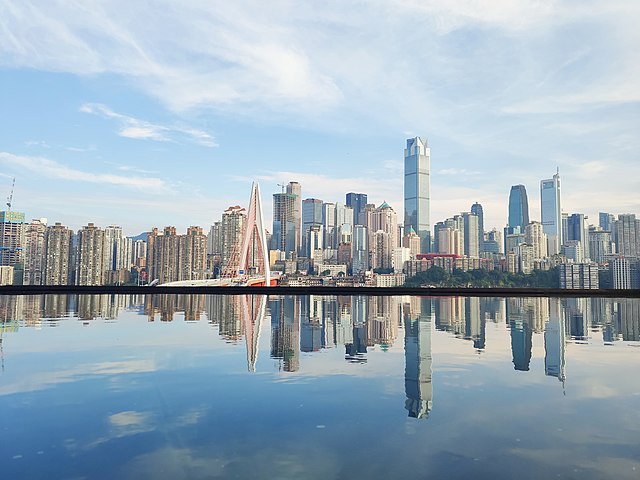
Can China Lead a World Economic Recovery?
By F. William Engdahl
13 January 2021
Image: 中文(中国大陆): 在重庆市嘉陵江江北区岸的中国农业银行重庆分行营业办公楼旁的水池,眺望渝中区半岛。(图中桥为千厮门嘉陵江大桥) English: On the bank of Jiangbei District, Jialing River, Chongqing,look-out the Yuzhong District Peninsula .(the bridge in the picture is the Qiansimen Jialing River Bridge). Dode honingbijen voor een bijenkast. Author: 夏枫水月 License: This file is licensed under the Creative Commons Attribution-Share Alike 4.0 International license.. License Source: https://commons.wikimedia.org/wiki/File:%E9%87%8D%E5%BA%86%E5%B8%82%E6%B8%9D%E4%B8%AD%E5%8C%BA%E5%8D%8A%E5%B2%9B.jpg
At the beginning of December China’s Xi Jinping officially declared that China had eliminated poverty entirely, part of his priority program. Western financial pundits have praised the remarkable economic recovery of China following the severe lockdowns a year go to combat the coronavirus. Predictions that China would once again, as it did in 2008, lead the rest of the world, especially the EU and North America, out of deep recession are common. Yet behind the official Beijing statements there are indications that China’s decades of economic boom are coming into deep problems, far deeper than officially acknowledged. If true, the consequences for the rest of the world as well as for China could be severe.
Eliminating by Definition?
On December 1, 2020 Chinese Communist Party (CCP) General Secretary Xi Jinping announced that China had achieved the goal of “eradicating absolute poverty” and becoming a “moderately prosperous society” before the end of 2020. At the November G20 summit in Riyadh, Xi boasted that this was ten years ahead of the deadline set by the United Nations 2030 Agenda for Sustainable Development. Yet as even Chinese analysts point out, there are major questions to this achievement.
A binding target to eliminate absolute poverty by the end of 2020 was incorporated into China’s 13th Five Year Plan (2016-2020) in November 23, 2016. Now impressively, the goal is declared won, and just on time.
However on closer scrutiny, it is not as impressive. Most of China’s poverty population are rural migrant populations living in subsistence farming or by other means in the central and western parts of China far from the prosperous coastal provinces. A China National Bureau of Statistics 2016 report stated that in 2015 the poverty rate was 1.8 percent in China’s highly developed and largely urbanized eastern provinces; 6.2 percent in central China, and 10 percent in Western China.
Yet China does not use the standard of the World Bank defining poverty in an upper-middle-income country, namely for daily income of $5.50 per capita. It uses approximately $1.90 a day, the value for the world’s poorest countries. Second it talks about only rural poverty, ignoring a significant urban poor quotient. Were China to use the World Bank poverty definition, instead of 1.7% poverty, China would have 17% poverty, a significant number. With the economic impact in 2020 from coronavirus lockdowns globally, today the poverty number is presumably higher, but unstated.
Indeed in May, the Chinese Premier, Li Keqiang, gave a sobering statistic at a press conference. He announced that roughly 600 million Chinese, or almost half the population, were eking out a living with a monthly income of 1,000 yuan (US$150) or less in 2019. Yet in the past two years inflation of everything from basic food to household appliances has often exceeded double digits. This all makes the next CCP economic priority a mirage.
Stimulating Domestic Consumption
The true state of poverty and real household income is crucial now, as the CCP has declared it will focus on domestic consumption to overcome loss of export revenues in the COVID era, a shift called “dual circulation” economy— expand exports and expand domestic consumption as well. How will China stimulate citizens with less than $150 monthly to lift the China economy? At the same press conference last May, broadcast on State TV, Li Keqiang stated, “One cannot even pay his rent with the money if he lives in a big city, let alone spend to improve his life or buy these export products to help manufacturers.”
The further problem is that the large, young new middle class in the recently built mega-cities such as Kunming, Xi’an, Chengdu, Shanghai or countless others with modern skyscraper apartments, are already loaded down with debt from buying new cars for the first time, and then buying an apartment amid rising real estate prices. Now the first signs of consumer debt default are appearing. Not only Americans are maxed out in debt.
Debt Crisis Growing
When the global financial crisis erupted in September, 2008, triggered by the Lehman Bros. bankruptcy, China’s Wen Jaibao implemented a staggering $4 trillion stimulus to keep its economy somewhat stable as world trade briefly collapsed. Around half of the $4 trillion was left to local governments to raise the capital, usually via special purpose infrastructure bonds or loans with local State Enterprises. That was the beginning of the debt buildup that today is leading to local government crises and collapse of numerous smaller banks in the past two years, well before the corona crisis and the US trade sanctions.
To keep their local economic targets after 2008, provincial party officials engaged in what is called shadow banking, undeclared, unguaranteed and unregulated by Beijing. It was a short term way to keep the economy going, done at the cost of a huge accumulation of municipal or provincial debt, much of it reportedly undeclared to Beijing. This hidden local debt has been growing in unknown dimensions. These so-called Local Government Finance Vehicles (LGFVs) debts began falling due in significant amounts by 2020 but many local governments lacked the funds to repay or rollover the bonds. There is $25.8 trillion officially estimated in central government guaranteed debt. Of that, debt of State Owned Enterprises such as ChemChina or Sinopec is $15 trillion or 95 trillion Renminbi. Then there is debt of the local divisions of the Communist party of China, another $6.3 trillion of declared debt. All this staggering amount of debt is known and de facto state guaranteed.
The problem comes with the local “undeclared” debts. Here no one knows the truth, as local officials chose to hide them to keep their regions growing and possibly to advance their career within the CCP by showing economic success. According to Liu Shijin, deputy director of the Economic Committee of the Chinese People’s Political Consultative Conference, “From the places investigated, it is at least no less than ‘declared debt’, and some of them are three times higher.” That would mean an added hidden local debt burden between $6.3 trillion to $18.9 trillion.
That is a huge debt time-bomb. It explains why the Chinese central bank and Beijing State Council have been trying to deleverage the local debt bomb since 2014. In an effort to bring the local hidden debt issuance under control, the Beijing Finance Ministry on December 9, 2020 published “Measures for the Administration of the Issuance of Local Government Bonds.” It tries to solve the issuance of local debt by handing liability and debt issuance to the local government as of 1 January. The issuance and redemption of local government bonds shall be handled by the public finance departments of local governments. According to the official Xinhua.net, “The local public finance department shall effectively perform the debt repayment liability, timely pay the principal and interest of bonds, and maintain the government reputation.” That is, it’s now your local problem.
This is a huge change. Previously, local government bonds were issued by the Beijing Ministry of Finance for the local government, and the money was lent back to the local government. If a local government was at risk of default the central government would step in. This new rule is a clear attempt after six years of recognizing the seriousness of the local hidden debt problem, for the central authorities around Xi Jinping to bring the hidden debt issuance to a halt. The problem is that, as no one knows the extent and how much of construction has been sustained so far using the hidden debt, the move could easily trigger large-scale municipal defaults that could in turn trigger a systemic debt crisis.
In this context, how will Beijing fill its central goal of stimulating consumption by especially the poorer regions and provinces?
Unemployment Large
The true number of unemployed is an added problem. Unemployed cannot take loans to buy apartments or new cars. The central government reports an official unemployment rate of single digits, between 6% to 7%, enviable in comparison with many OECD countries. However, in a curious anomaly, China statistics office defines “unemployed” as strictly urban unemployed. Beijing’s data does not include people in rural communities or a large number of the 290 million migrant workers who work in construction, manufacturing and other low paying jobs. According to a 2020 study by Zhang Bin, an economist at the Chinese Academy of Social Sciences, a government think tank, if those migrants are included, as many as 80 million people could have been out of work at the end of March, 2020, some 10% to 13% of the workforce, with some private economists estimating it could be as high as 20%.
With already seriously high unemployment and a credit system imposing de facto deflation, it is difficult to see how China in 2021 can implement Xi’s Dual Circulation of stimulating domestic consumption and export growth via the Silk Road. This is against a backdrop of the world’s most rapidly ageing population, which in 2018 saw a decline in total population for the first time since Mao’s “Great Leap Forward” in the 1960’s.
The global consequences of a Chinese economy entering into a prolonged downturn and a simultaneous debt default crisis will have severe consequences for the global economy. As well, the pandemic lockdowns across the EU and USA will hit China’s huge export economy. Already there are indications that China’s ability to open new export markets via its Belt and Road Initiative, the New Economic Silk Road, is being seriously impaired. The December 8 Financial Times of London reported a study by Boston University researchers which concluded that the Communist Party of China has significantly reduced overseas loans of the two largest state banks well before the corona crisis. They note that in 2019, the total overseas loans of the China Development Bank and the Export-Import Bank of China were $4 billion, far lower than the record $75 billion in 2016. The two banks lent $462-billion between 2008 and 2019, much for Silk Road projects abroad.
With tens of billions of past loans to financially weak states such as Pakistan, Ethiopia, Venezuela now in near default, or in renegotiation, it’s a serious question whether the new markets Beijing hoped to win by the Silk Road will instead become a debt albatross for the state at a time it faces a serious internal debt crisis. A Chinese economic collapse or even serious recession is what the world does not need at this juncture.
F. William Engdahl is strategic risk consultant and lecturer, he holds a degree in politics from Princeton University and is a best-selling author on oil and geopolitics, exclusively for the online magazine “New Eastern Outlook”




